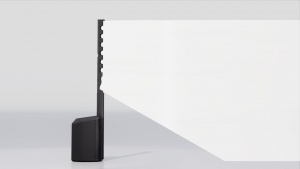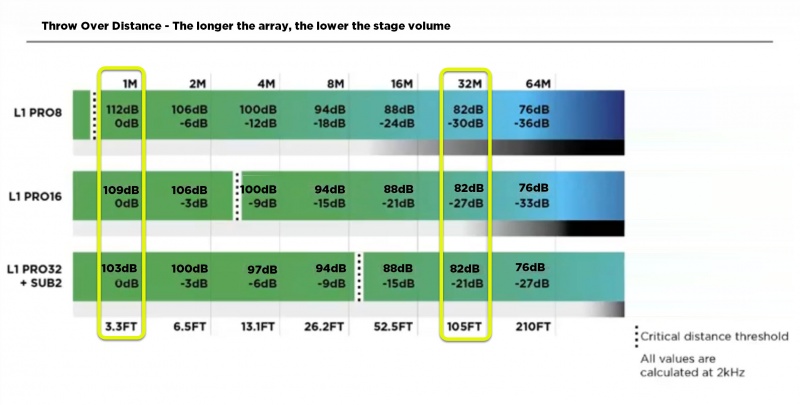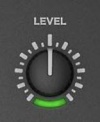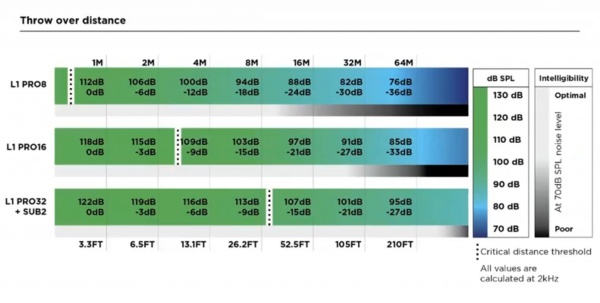Should I get an L1 Pro16 or L1 Pro32
|
This article expresses my opinion and experience. Please post comments to Twitter @ST_Muso or LinkedIn @STPro. Thank you — ST. |
Should I get an L1 Pro16 or L1 Pro32?
If you are considering the L1 Pro16 and L1 Pro32 and trying to understand which is a better choice for you, then keep reading. I'll tell you what I considered as I pondered this question.
Too long didn't read - 🎬 Spoiler Alert
I got both: two L1 Pro16 and two L1 Pro32 with Sub1 subwoofers. The L1 Pro16 has unique features that make it the right choice for some applications. The L1 Pro32 has unique features that make it the right choice for other applications. In the rest of this article, I will discuss the merits of both and why you might want one or the other. For a detailed comparison of the specifications please see 👉the table at the bottom of the article.Background
I've enjoyed both the L1 Model 1S and the L1 Model II for over a decade. I mention these legacy models because they are the predecessors to the L1 Pro16 and L1 Pro32. This is how I used them and why I was interested in the new systems. Getting either of these new systems would mean replacing the older ones.
L1 Model 1S
I got the L1 Model 1S with B2 bass module in 2012. The reasons:
- The L1 Model 1S vertical dispersion is 10° (+/- 5°). The L1 Model II had 0-degree vertical projection. This meant the L1 Model 1S could be useful when the audience was slightly above or below the stage. See L1 Model 1S Compared to L1 Model II Vertical Dispersion for more information.
- The B2 could be as loud as four B1s without requiring an extra amplifier.
L1 Model II
I got the L1 Model II with two B1 Bass Module bass modules and T1 ToneMatch Audio Engine in 2009. For solo work, I sing and play acoustic guitar (or electric guitar). Most often I would use a single B1 Bass Module. For larger shows or outdoors, I would use two B1 bass modules. When playing in bands, I bring the same equipment but I generally play electric guitar with a Kemper Profiler. I don't need much bass because I've got a rhythm section (bass guitar and drums). In most band settings, we set up an L1 for each performer. We would use up to four B1 bass modules for bass guitar or drums. When the B2 became available, we would use that.
The New L1 Pro16 and L1 Pro32
Similarities
Both the L1 Pro16 and L1 Pro32 have three channels (two with ToneMatch Presets, Tone controls, and Reverb). The third channel can receive Bluetooth audio or line-level inputs. Both units can be controlled using the Bose Music App, and you can connect a ToneMatch mixer to the ToneMatch port.
Differences
- Is the L1 Pro32 a step up from the L1 Pro16? Yes and No
L1 Pro32 is a step up from the L1 Pro16
- The projection over distance is greater with the L1 Pro32. This is because the line array is twice as long (32 drivers) and powered by 480 watts RMS. The L1 Pro16 has 16 drivers powered by 240 watts RMS.
- Run the L1 Pro32 at a lower stage volume than the L1 Pro16. Lower stage volume means less likelihood of feedback.
- When used with the Sub1 subwoofer, the L1 Pro32 is more portable than the L1 Pro16. The heaviest component is 34.1 pounds for the Sub1 compared to 43 pounds for the L1 Pro16 power stand.
- Multiple options with the separate Sub1 and Sub2. See Sub1 and Sub2 for details
- Separate subwoofers from the L1 Pro32 array
- Scale the bass up or down as required by the gig
- The L1 Pro32 is sold with a Sub1 or a Sub2. You can use the Sub1 or Sub2 as a subwoofer for other powered loudspeakers like an S1 Pro.
L1 Pro32 is NOT a step up from the L1 Pro16
- The L1 Pro16 has a J-shape vertical projection. This is most useful when playing on an elevated stage with members of the audience below the stage level.
The L1 Pro32 will sound muffled to an audience below the vertical sound field. - The L1 Pro16 power stand has the 10"x18" racetrack driver powered by 1000 watts RMS. However, the overall size and volume of the L1 Pro16 is smaller than the Sub2 with the same driver and wattage. The L1 Pro16 output is the same as the Sub1 at 118 dB SPL continuous (124 db SPL peak) output. For more information see Sub Comparison.
- The L1 Pro16 footprint on stage is smaller (14 x 18 in) than the L1 Pro32 with a Sub1 (23.4 x 21.7 in) or Sub2 (25.6 x 21.7 in).
- The L1 Pro16 total system weight is less than the L1 Pro32 with either Sub1 or Sub2. However, the L1 Pro16 power stand is bigger and heavier than the Sub1.
L1 Pro16
The L1 Pro16 is a convenient, all-in-one package with a surprisingly small footprint on the stage taking only 14 x 18 inches. That's slightly over half of the stage area of older full-sized L1 models. They were 26 x 26 inches.
It provides more bass than the legacy B2 bass module even though the power stand weighs only a few pounds more. It uses the same 10 x 18" racetrack driver as the Sub2 subwoofer option with the L1 Pro32.
The L1 Pro16 has a J-shaped array. It provides the best coverage (of all the L1 models) for audiences below an elevated stage.If all my gigs were in venues up to 75 feet the L1 Pro16 would meet my needs. I prefer to have the L1 behind me on stage, and prefer not to run my stage volume above 100 dB SPL. At 75 feet, the projected volume drop is approximately -24 dB. See the coloured chart below 'Throw Over Distance'
The L1 Pro16 downward coverage makes it the best when some or all of the audience is below the stage.
L1 Pro32
Throw Over Distance
The line array in the L1 Pro32 is twice as long as the L1 Pro16. It is driven by a larger amplifier and provides higher volume and lower drop-off over distance. This means the Throw Over Distance is greater. For example, the -24 dB expected at 75 feet with the L1 Pro16 happens at well over 100 feet with the L1 Pro32.
Lower Stage Volume
In many venues, you can run the L1 Pro32 at a lower stage volume than the L1 Pro16 (and L1 Pro8) and still reach everyone.
In this example adapted from the Throw Over Distance chart, our objective is to be heard at 82 dB SPL at 32 meters (100 feet). To reach this goal:
- L1 Pro8 stage volume is 112 dB SPL
- L1 Pro16 stage volume is 109 dB SPL
- L1 Pro32 stage volume is 103 dB SPL
The L1 Pro32 is a better choice:
- If you prefer lower stage volumes
- Note: Running at lower stage volumes can reduce the likelihood of feedback.
- If you need even volume from the front to the back of a venue
- People closer to the stage will not be subjected to excessive volume
- In my area, there are restrictions on the volume of music in live venues. Live music is to be no louder than conversational level. They don't want people to have to raise their voices or lean in close to be heard. Lower stage volume and even volume throughout the venue are highly desirable these days.
Sub1 and Sub2
Scale Up or Down
You have several options with the subwoofers to scale to your needs with the L1 Pro32:
- Single Sub1
- Double Sub1 (cardioid mode or not)
- Single Sub2
- Double Sub2 (cardioid mode or not)
- Sub1 plus Sub2 (see the video to the right for more details at 1:39)
Connect the L1 Pro32 to the Sub2. On the Sub2, set the Line In filter to L1. Set the Line Out HPF on and connect the Sub1. The result is, the Sub2 plays all the frequencies below 200 Hz. The Sub1 plays the frequencies from 100 to 200 Hz. Control the mix using the Level control on the Sub1.
Separate from the L1 Pro32 for Flexibility
The subwoofers are separate from the power stand. This means you can position them for optimum results for the venue. For examples:
- Put the subwoofers together.
- Move the subwoofers off a resonant stage
- Place subwoofer in front of the stage
- Pair them in cardioid mode and aim the bass where you need it (typically at the audience and away from the stage)
Raise and Lower the Bass Independently
The Sub1 and Sub2 have a separate level control.Start with the control at 12:00 o'clock (Unity). Then fine-tune the balance of bass frequencies with the mid-high frequencies covered by the L1 Pro32.
You may choose to raise that at low volume levels, and reduce it at high volume levels.
Does the Array Out-distance the Subwoofers?
There have been some discussions online about the L1 Pro32 array being able to outdistance the Sub1 or Sub2. You may experience this outdoors or in applications where you are running at a distance at high volume.- The Sub1 and Sub2 are point-source loudspeakers. The volume drops off at about -6 dB SPL for every doubling of the distance. The L1 Pro32 portable line array drops off at about -3 dB for every doubling of the distance (up to the critical distance). As you move farther away from the system, the volume of the subwoofer will drop off faster than the line array. See Bass Outdoors for a discussion of the concepts.
You can scale up the bass to meet the needs of your situation (two Sub1 instead of one or two Sub2 instead of one).
Other Benefits of the Longer Array
The L1 Pro32 has a much more gradual drop in volume over distance compared to the L1 Pro16. You don't have to be playing loud or to a distant audience to experience the benefits.
Use the L1 Pro32 for the even volume from the front to the back of the venue. This means you can run at lower stage volumes, play at moderate levels (not blast people close to the stage), and lower the likelihood of microphone feedback.
Two L1 Pro16 or One L1 Pro32
One L1 Pro32
The L1 Pro32 can project twice as far in every direction as the L1 Pro16. Another way to view that, at distances over 25 feet (8 meters), the L1 Pro32 can be as much as +10 dB SPL louder than an L1 Pro16. +10 dB SPL is perceived as twice as loud.
- Note
- Two identical systems (e.g., two L1 Pro16) may be up to +3 dB SPL louder than one. (Not twice as loud).
Because all L1 Pro systems have 180-degree horizontal dispersion, a single system can often reach the whole audience area. You don't need two systems as you do with other systems with narrower horizontal dispersion.
If you take two L1 Pro16 systems and separate them, you can get more coverage than one. (More = the distance between them, side-to-side), but you don't get more projection in front of them. You can expect the L1 Pro32 to cover twice the area of two L1 Pro16 systems and with a Sub2, provide substantially more bass.
Two L1 Pro16
Reasons to choose two L1 Pro16 over a single L1 Pro32:
- For two performers: Run the systems independently, with each performer heard through only one L1 Pro.
- You and your audience get the benefits of the Cocktail Party Effect
- Two or more performers. Use two systems to split the vocal microphones and increase your gain before feedback. Here's why:
- For every doubling of the number of microphones heard through one loudspeaker, you lower your gain before feedback by up to -3 dB
- For every doubling of the number of loudspeakers connected to a microphone, you lower your gain before feedback by up to -3 dB
- If you run two microphones into two loudspeakers (dual mono), you are doing both of the above
- If you split the microphones so each microphone is heard through only one loudspeaker, you increase your gain before feedback compared to running all the microphones through one or more loudspeakers
- Stereo. If you are running prerecorded music in stereo (e.g., backing tracks), you need two systems to play stereo
The Bottom Line
If you have an L1 Pro16, there's no need to get an L1 Pro32 unless you need:
- The ultra-portability of the L1 Pro32 (34.1 pounds for the Sub1 vs. 43 pounds for the L1 Pro16 power stand)
- The tight vertical coverage (limited projection above and below the stage). See the chart below.
- The significantly greater Throw Over Distance.
- More even volume from the front to the back of a venue.
- Running at lower stage volumes. This means more projection/coverage before feedback.
Comparison Table
| Feature | Bose L1 Pro16 | Bose L1 Pro32 |
|---|---|---|
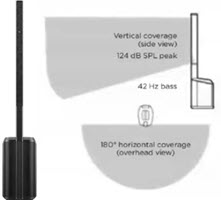 |
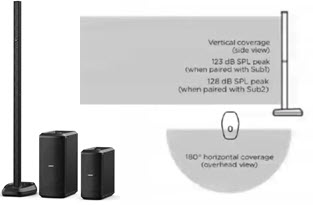 |
|
| Feature | Bose L1 Pro16 | Bose L1 Pro32 |
| Horizontal dispersion | 180 degrees | 180 degrees |
| Vertical dispersion | 0/-30 degrees (J-shape) | 0 degrees (straight shape) |
| Output | 118 dB / 124 dB peak | With Sub1: 117 dB / 123 dB peak
With Sub2: 122 dB / 128 dB peak |
| Speaker Array | Sixteen 2.00" (51 mm) articulated cricket drivers | Thirty two 2.00" (51 mm) articulated cricket drivers |
| Woofer | One 10"x 18" neodymium racetrack transducer in the power stand | Sub1:One 7" x 13" neodymium racetrack transducer
Sub2:One 10"x 18" neodymium racetrack transducer |
| Low Frequency | 42 Hz - 3dB | With Sub1: 40 Hz - 3dB With Sub2: 37 Hz - 3dB |
| Crossover | 200 Hz | 200 Hz |
| Power to speakers | Biamped
|
Biamped
|
| Weight | Total system weight 18 kg (54.9 lb)
|
Total system weight with
Sub1 29.1 kg (62.7 lb) Sub2 36.4 kg (79.3 lb)
|
| Dimensions (H x W x D) | 201.2 x 35.5 x 45.6 cm
(79.2 x 14.0 x 18.0 in) |
L1 Pro32
213.5 × 34.5 × 55 cm (84.1 × 13.6 × 21.7 in) Sub1 53.0 × 25.0 × 53.0 cm (20.9 × 9.8 × 20.9 in) Sub2 69.0 × 30.5 × 55.0 cm (27.2 × 12.0 × 21.7 in) Footprint (floor space required) L1 Pro32 with Sub1 (W x D) 59.4 x 55.1 cm (23.4 x 21.7 in) L1 Pro32 with Sub2 (W x D) 65.0 x 55.1 cm (25.6 x 21.7 in) |
| Power Stand Height (front | rear) | 66 front | 62.23 rear cm
26 front | 24.5 rear inches |
10.16 front | 10.16 rear cm
4 front | 4 rear inches |
| Sound Projection | 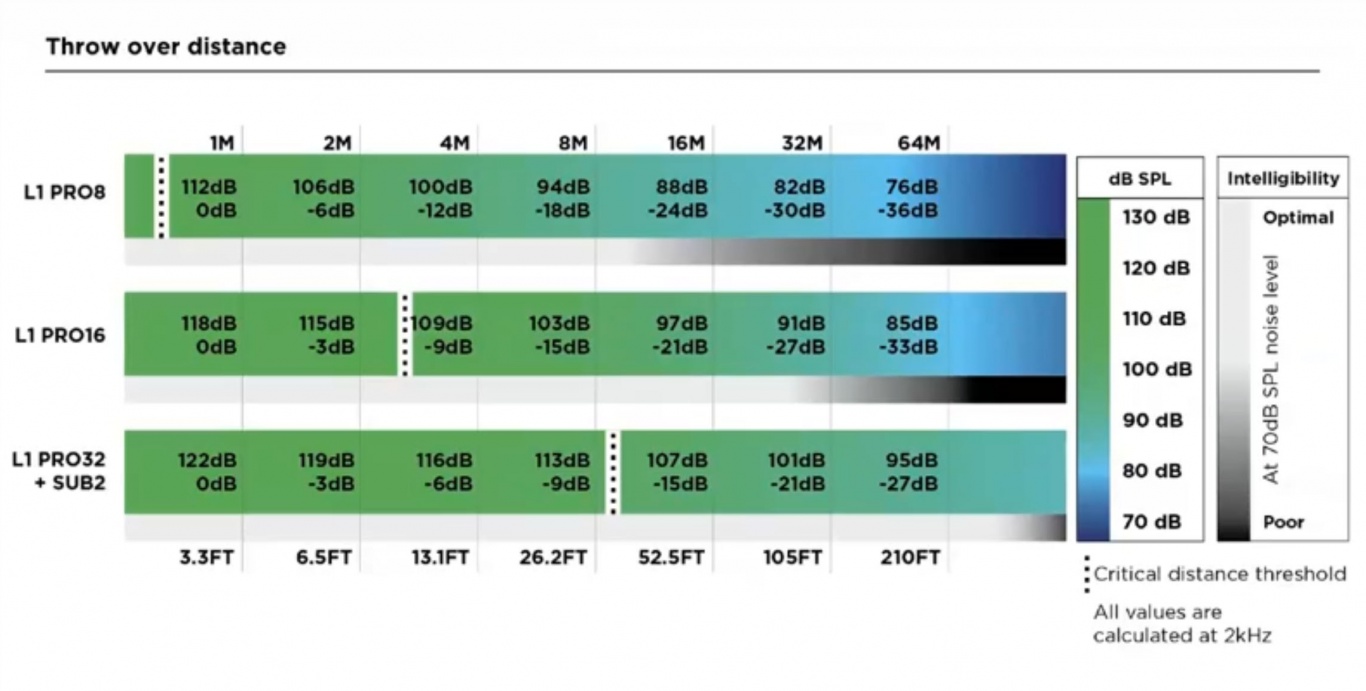
|
|
| Everything below this bar is the same for both | ||
| ToneMatch® Presets | Channels 1 and 2 Full suite of ToneMatch Presets available in the ToneMatch mixers, built-in. Set using the L1 Mix App. |
Channels 1 and 2 Full suite of ToneMatch Presets available in the ToneMatch mixers, built-in. Set using the L1 Mix App. |
| Battery | No | No |
| Connections | Channels 1 and 2
Combo Jacks XLR / 6 mm (1/4" Tip-Ring or Tip-Ring-Sleeve) balanced / unbalanced Channel 3/Aux Input
|
Channels 1 and 2
Combo Jacks XLR / 6 mm (1/4" Tip-Ring or Tip-Ring-Sleeve) balanced / unbalanced Channel 3/Aux Input
|
| Tone Controls | Channels 1 and 2 * Bass / Treble Channel 3 * None | Channel 1 * Bass / Treble Channel 2 * None |
| Line Out | XLR balanced | XLR balanced |
| Bluetooth input | Yes: Channel 3
Supports Bluetooth 5.x |
Yes: Channel 3
Supports Bluetooth 5.x |
| Reverb | Channels 1 and 2 Yes Channel 3 None |
Channels 1 and 2 Yes Channel 3 None |
| ToneMatch Port | Yes full support for T4S/T8S power only for T1 |
Yes full support for T4S/T8S power only for T1 |
| System EQ | Yes Live/Music/Speech/Off |
Yes Live/Music/Speech/Off |
| Scenes | Yes Store/recall system settings via Bose L1 Mix App |
Yes Store/recall system settings via Bose L1 Mix App |
| Bose L1 Mix App | Yes Wireless control over volume, tone, reverb and system EQ |
Yes Wireless control over volume, tone, reverb and system EQ |
Documentation
L1 Pro8
L1 Pro16
L1 Pro32
Sub1/Sub2
L1 Pro Technical Data Sheets
- L1 Pro8 Technical Data Sheet
- L1 Pro16 Technical Data Sheet
- L1 Pro32 Technical Data Sheet
- Sub1 Technical Data Sheet
- Sub2 Technical Data Sheet
L1 Pro Self-Serve Support
Application Guide


